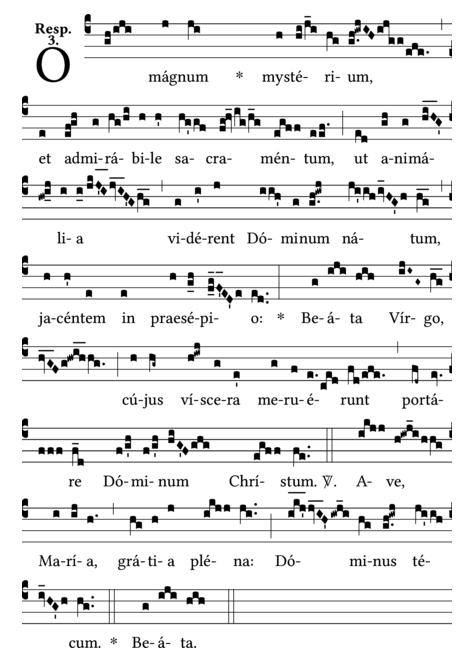
English: Gregorian Chant Responsary: "O, Magnum Mysterium".
Deutsch: Gregorianisches Responsorium O Magnum Mysterium.
Date: Mediaeval.
Author: Unknown.
(Wikimedia Commons)
"O, Magnum Mysterium".
Composed by: Morten Lauridsen.
Sung by: Westminster Cathedral Choir.
Available on YouTube at
The following Text is from Wikipedia - the free encyclopaedia.
"O, Magnum Mysterium" is a Responsorial Chant from The Matins of Christmas.
Latin.
O, Magnum Mysterium,
et admirabile sacramentum,
ut animalia viderent Dominum natum,
iacentem in praesepio !
Beata Virgo, cujus viscera
meruerunt portare
Dominum Iesum Christum.
Alleluia !
English.
O, Great Mystery,
and wonderful Sacrament,
that animals should see The New-Born Lord,
lying in a Manger !
Blessed is The Virgin whose womb
was worthy to bear
The Lord, Jesus Christ.
Alleluia !
"The Nativity".
Artist: Hans Baldung.
Date: 1520.
Current location: Alte Pinakothek, Munich, Germany.
Source/Photographer: The Yorck Project (2002) 10.000 Meisterwerke der Malerei (DVD-ROM). Distributed by DIRECTMEDIA. Publishing GmbH. ISBN: 3936122202.
(Wikimedia Commons)
The image of the Oxen and Donkey, next to The Crib, is found in Isaiah (Isa. 1.3) and is Traditionally related to The Nativity scene at The Birth of Jesus, in Luke 2.
Luke (Lk 2.7) does not mention animals, but a Manger. In the apocryphal Gospel of Pseudo-Matthew, both animals are specifically named. The image continued to spread from the 13th-Century onwards, when it was included in The Golden Legend. It became the most popular symbol for The Mystery of The Self-Abasement of God in His Incarnation. (Phil 2,6–7).
The second part of The Responsory relates to the words with which Elizabeth welcomes Mary, Mother of Jesus, on her Visitation (Lk 1.42–43).


No comments:
Post a Comment